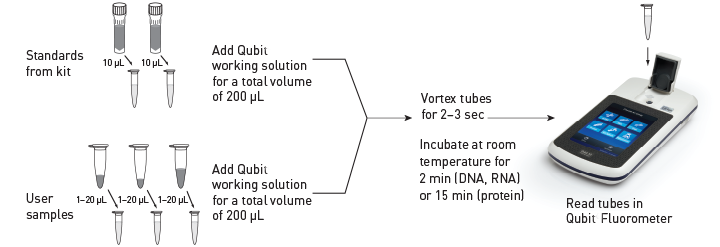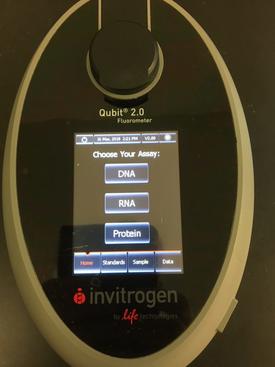Qubit 2.0 Fluorescence Reader for DNA, RNA and Protein
(user operated)
No reservation needed, but please sign up for each usage at our Reservation and Billing site. We have all reagents for assays, and we charge per sample so that you do not have to purchase your own reagents.
For pricing per sample see our Rates page.

Applications
- This popular instrument is a fluorescence reader for individual tubes that is used in conjunction with reagents kits to quantify dsDNA, ssDNA, RNA, and protein.
- This reader is easy to use and much more sensitive that the Nanodrop and is the method of choice for quantifying Illumina libraries or low concentration samples.
- Since it measures fluorescence (not aborbance) the Qubit does not detect UV absorbing materials such as free nucleotides, DNA contamination in RNA preps, or RNA contamination in DNA preps.
- The Qubit is very simple to use and reagents and standards are supplied to users who are charged a modest cost per sample.
Specifications
- The instruments has built-in programs for dsDNA (high sensitivity), dsDNA (broad range), RNA, ssDNA, and protein.
- Sensitivities are:
- dsDNA BR (broad range) 2-1000ng
- dsDNA HS (high sensitivity) 0.2-100ng
- ssDNA 1-200ng
- RNA HS (high sensitivity) 5-100ng
- protein 1-500ng.
- For more information on Qubit 2.0 reagents see the ThermoFisher web site.
- Although the Nanodrops are advertised as sensitive to 2ng/ml, they are not particularly accurate at such low concentrations. For samples below about 20ng/ul we would recommend the Qubit reader. It is more sensitive and is not affected by UV absorbing materials such as free nucleotides that can result in an overestimation for DNA or RNA.
Supplies and Assistance
- Reagents are supplied by the Genomics Core and included in the per sample price.
- We stock DNA, RNA and protein reagents.
- For assistance with the Qubit, contact the Genomics Core staff.
